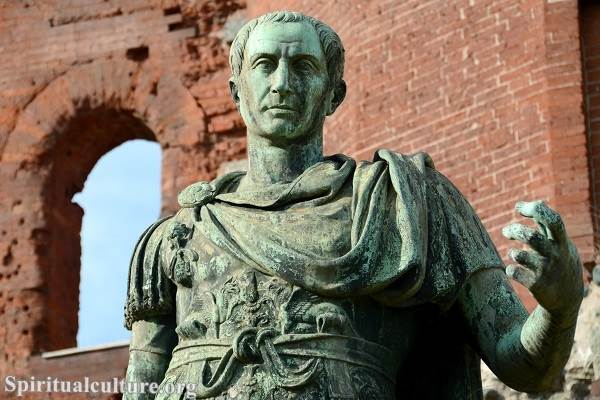The life, achievements, and untimely demise of Caesar not only shaped the trajectory of the Roman Republic but also left an indelible mark on the cultural and political landscape of the modern world.

In this article, Spiritual Culture explores in-depth the facts about Julius Caesar, examining his early life, remarkable military career, political ascent, innovative reforms, assassination, and the enduring influence of his legacy.
Early Life and Family Background
Birth and Ancestry
Gaius Julius Caesar was born on July 12 or 13, 100 BCE, into a patrician family in Rome. His ancestry claimed a connection to the legendary Trojan prince Aeneas, a revered figure in Roman mythology who was said to have founded the city of Rome. This lineage added a layer of divine legitimization to Caesar’s identity, intertwining his political narrative with themes of destiny and ancestry.
Caesar’s family belonged to the Julii, one of the oldest and most distinguished noble families in Rome, yet they lacked the wealth and influence of other patrician houses. Interestingly, the name “Caesar” is often thought to derive from the Latin term “caesus,” meaning “cut,” potentially hinting at a forefather born by Caesarean section. However, this etymology is contested and remains a matter of speculation.
Family and Upbringing
Caesar’s father, Gaius Julius Caesar Sr., served as a praetor, a significant judicial and political role in the Republic. His position likely exposed young Caesar to the intricacies of Roman politics and governance. His mother, Aurelia Cotta, was an influential figure in his upbringing, known for her intelligence and strong moral character. Aurelia shaped Caesar’s early values, instilling in him a love for education and the ideals of Roman virtue.
Growing up in a politically charged atmosphere, Caesar experienced a tumultuous childhood filled with power struggles within the Roman Republic. Following the death of his father when Caesar was only 16, he became increasingly aware of the perilous nature of political life. He recognized the fragility of power and the need for strategic alliances, skills that would later become essential to his rise in Rome.
In his youth, Caesar received an education typical of a young patrician, focusing on subjects such as Greek and Latin literature, rhetoric, and philosophy. This education was instrumental in developing his exceptional oratorial skills, which would later captivate audiences and sway the Senate in his favor. Notably, he was known for his eloquence, displayed in his public speeches, which helped him gain popularity among the Roman people.
Connection to the Trojan Prince Aeneas
The mythological connection between Julius Caesar and Aeneas is crucial in understanding how Caesar leveraged his heritage for political gain. Aeneas was a Trojan hero celebrated for his strength and leadership, and he was believed to be the ancestor of Romulus and Remus, the purported founders of Rome. This lineage served not only to enhance Caesar’s image but also to create a narrative of legitimacy that stretched back to Rome’s mythical origins.
Caesar often portrayed himself as a leader destined to restore Rome to greatness, aligning with the heroic aspects of Aeneas’ story. This connection resonated with the Roman populace, who revered the legacy of their mythical heroes. By associating himself with Aeneas, Caesar positioned himself as a pivotal figure in Rome’s ongoing narrative, suggesting that he was not merely seeking power but fulfilling a divine mission to guide Rome forward.
Military Career
Early Military Successes
Caesar’s military career commenced around 78 BCE when he began serving under the general Gnaeus Pompeius Magnus, commonly known as Pompey the Great, in the eastern Mediterranean. Initially, he distinguished himself during the campaigns against pirates and in the areas surrounding the Mediterranean Sea. These early successes were vital for his rising reputation as a capable military commander.
His formative military experience was solidified when he was captured by pirates around 75 BCE while en route to Rhodes. Displaying remarkable confidence, Caesar boldly told his captors that he would be back to crucify them, a threat he executed after securing his release. This story, though somewhat apocryphal, encapsulates his audacity and determination, traits that would define much of his military career.
Following his release, Caesar assembled a naval force, captured the pirates, and fulfilled his promise by executing them. This bold move enhanced his reputation in Rome as a strong and fearless leader willing to go to great lengths to achieve justice.
The Gallic Wars
The hallmark of Caesar’s military brilliance can be seen during the Gallic Wars, fought from 58 BCE to 50 BCE. As governor of the province of Gaul, he took on a series of military campaigns that showcased not only his strategic acumen but also his capacity to govern and integrate vanquished peoples into the Roman system.
Caesar’s Commentarii de Bello Gallico (Commentaries on the Gallic War) serves as both a historical account and a piece of propaganda. In it, he describes multiple campaigns against various tribes, including the Helvetii, who sought to migrate into Roman territories, and the Belgae, a coalition of tribes that posed a significant threat to Roman dominance.
One of the critical battles occurred in 58 BCE at the Battle of Bibracte, where Caesar’s legions adeptly defeated the Helvetii, compelling them to retreat. This victory established Caesar as a formidable commander and strengthened his position in Rome.
The Gallic Wars reached their climax with the dramatic campaign against Vercingetorix, the chieftain of the Arverni tribe. Vercingetorix united various Gallic tribes against Rome, posing a significant challenge to Caesar’s authority. The decisive Battle of Alesia in 52 BCE showcased Caesar’s tactical genius. Despite being outnumbered, Caesar built extensive fortifications and utilized innovative siege tactics, resulting in a pivotal victory that led to the surrender of Vercingetorix.
By the end of the Gallic Wars, Caesar had expanded Rome’s territory significantly, establishing control over all of Gaul. His military successes earned him immense popularity among the Roman populace and legions, consolidating his power and influence, making him not only a general but a national hero.
Crossing the Rubicon River
In 49 BCE, the political climate in Rome grew increasingly tumultuous as rivalries intensified. Tensions between Caesar and Pompey escalated, culminating in a critical decision that would alter the course of Roman history: Caesar’s crossing of the Rubicon River. Standing at the edge of the river with his army, Caesar faced a defining moment. Crossing the Rubicon—considered a direct violation of Roman law and a declaration of war—symbolized a point of no return.
According to historical accounts, Caesar famously declared, “The die is cast” (Alea iacta est), acknowledging the irreversible nature of his choice. This bold move instigated a civil war against Pompey and his supporters, plunging Rome into conflict. Caesar’s crossing of the Rubicon served as a dramatic assertion of defiance against the Senate’s authority, challenging the established political order.
The subsequent civil war saw a series of military engagements, with Popey ultimately retreating to Greece. Caesar’s victory at the Battle of Pharsalus in 48 BCE was decisive, leading to Pompey’s defeat and eventual assassination. This victory solidified Caesar’s control over Rome, marking the pinnacle of his military career.
Political Ascent
Formation of the First Triumvirate
The complexities of Roman politics necessitated the formation of strategic alliances, resulting in the creation of the First Triumvirate in 60 BCE. This informal political alliance between Caesar, Pompey, and Marcus Licinius Crassus, the wealthiest man in Rome, aimed to consolidate power and bypass the traditional Senate’s authority. Each member brought unique strengths: Crassus provided vast financial resources, Pompey contributed military prestige, and Caesar offered popular support among the plebeians.
Their collaboration enabled significant legislative achievements, including land reforms and expanding military commands that benefited each member. However, underlying tensions existed within the Triumvirate, primarily stemming from the ambitious nature of Caesar and his deepening rivalry with Pompey.
Political Alliances and Rivalries
As Caesar’s power increased, he skillfully navigated the complex political landscape, forging alliances and rivalries with various factions within the Senate. He was known for his ability to speak to the masses, and through his populist policies, he garnered immense support among lower-class citizens, known as plebeians. This support provided him a broader base of power, countering the traditional patrician elite represented in the Senate.
However, his growing popularity and consolidation of power fueled resentment among aristocratic senators, particularly individuals like Cato the Younger and Cicero, who viewed him as a direct threat to the Republic’s values and institutions. Political maneuvering reached a breaking point after Crassus’ death in 53 BCE during a failed campaign against Parthia, effectively dismantling the Triumvirate and pitting Caesar and Pompey against each other.
In 49 BCE, the Senate, fearing Caesar’s rising power, declared him an enemy of the state and ordered him to disband his army. This ultimatum, along with Pompey’s alliances with senatorial conservatives, galvanized Caesar’s resolve and pushed him to take decisive action.
Title of Dictator
Following his military triumphs in the civil war, Caesar returned to Rome as a conqueror. In 46 BCE, he was appointed dictator for a ten-year term—a title rarely held outside of extreme national crises. This position granted him unprecedented authority and control over the Roman government. A year later, the Senate proclaimed him dictator perpetuo, or dictator for life. This elevation to power stirred widespread apprehension among the traditional senatorial class, who viewed Caesar’s actions as a veiled attempt to establish a monarchy.
While Caesar enacted numerous reforms aimed at addressing long-standing issues within the Republic, his consolidation of power prompted fears of tyranny. The measures he implemented included land redistribution, extensions of citizenship to diverse regions, and administrative reorganizations that enhanced his control and reduced senatorial influence. While these reforms garnered support from the populace, they alienated many senators and elite individuals who felt their authority diminishing.
Major Reforms and Policies
Social and Political Reforms
During his rule, Caesar’s reforms reflected a blend of pragmatism and populism. He initiated policies aimed explicitly at addressing class disparities, which had become increasingly pronounced in the years leading up to his reign. One of his notable measures was the distribution of land to veterans and the urban poor, attempting to solve problems of poverty and unemployment that plagued Rome.
In addition to land reforms, Caesar expanded citizenship to people in distant provinces, recognizing that integrating these regions into the Roman Empire would foster loyalty to his rule and create a more unified political structure. This expansion of citizenship was a significant move, as it diluted the power held by the traditional patrician class while simultaneously creating a broader base of support. By bringing new citizens into the fold, he strengthened Roman identity and allegiance to the state, which had been threatened by internal conflicts.
Moreover, Caesar took steps to address inefficiencies within the bureaucratic system. He reorganized provincial governance, ensuring that governors were accountable for their actions. This restructuring sought to curb the corruption that had become endemic in some areas and presented a more streamlined and efficient form of government. His appointments were often based on merit rather than noble lineage, which further alienated established elites.
Economic Reforms
Economic stability was a crucial aspect of Caesar’s rule, and he implemented several reforms aimed at revitalizing the Roman economy. He recognized that persistent debt was a driving force behind social unrest, prompting him to introduce measures that alleviated the burden on the lower classes. For instance, he passed laws that limited the interest rates on debts and facilitated debt cancellations, which helped many struggling citizens regain their financial footing.
Caesar also focused on practical economic improvements, such as initiating vast public works projects that created jobs and improved infrastructure throughout the Republic. His vision included roads, temples, and public buildings that were not only functional but also served to glorify Rome and display his power as a benevolent leader. The construction of these projects was a means to achieve both economic growth and increased favor among the populace, further solidifying his position.
Another significant aspect of Caesar’s economic reforms was the introduction of the Julian calendar in 45 BCE. Faced with inaccuracies in the previous lunar calendar system, Caesar implemented a solar calendar with 365 days and a leap year every four years. This monumental change not only improved timekeeping but also greatly simplified agricultural planning, ultimately benefiting the broader economy.
The Julian Calendar
The Julian calendar is perhaps one of Caesar’s most enduring legacies. The transition from the lunar to the solar calendar represented a major advancement in how time was managed within the Roman Empire. Prior to this reform, the Roman calendar had grown overly complex and misaligned with the seasons, leading to confusion regarding agricultural cycles and festivals.
By adopting a solar year comprising 365 days, with an extra day added every four years, Caesar created a system that provided stability and predictability. This calendar reform was pivotal not only for Rome but also influenced how countless societies managed time in subsequent centuries. The Julian calendar served as a precursor to the Gregorian calendar, which is still used globally today, highlighting the lasting impact of Caesar’s governance.
Assassination
Events Leading to the Assassination
As Caesar’s influence expanded, the growing fears of his perceived tyranny gathered momentum. His appointment as dictator perpetuo, while popular among various segments of society, alarmed many in the Senate. They viewed him as a direct threat to the Republic and the principles of collective governance that had been established.
In the lead-up to his assassination, several conspirators, including Gaius Cassius Longinus and Marcus Junius Brutus, united in their mission to eliminate Caesar. These individuals, disillusioned by his autocratic style of leadership, envisioned the assassination as a means to restore the Republic and its traditional values. The conspirators gathered support, hoping to convince others that Caesar’s removal was a necessary act to preserve Roman democracy.
Amidst a growing atmosphere of unrest, ominous omens and prophecies surfaced, warning Caesar of impending danger. One famous encounter occurred when a soothsayer warned him to “Beware the Ides of March.” Despite these warnings, Caesar attended the Senate meeting on March 15, 44 BCE, believing in his invulnerability and the loyalty of his supporters. Ironically, this confidence would lead to his downfall.
Key Figures Involved
The plot against Caesar was coordinated by a group of around 60 senators, with Cassius and Brutus emerging as the most prominent leaders of the conspiracy. Cassius, a seasoned commander who had fought alongside Caesar, felt betrayed by the shift from ally to dictator. Brutus, on the other hand, was admired by Caesar and viewed as a trusted friend. His involvement added a layer of tragedy to the assassination, as Brutus’ betrayal struck at the core of personal loyalty.
The conspirators meticulously planned the assassination, timing it to occur during a Senate meeting when they knew Caesar would be present. The attack unfolded swiftly. As Caesar entered the Senate chamber, he was surrounded by the conspirators who struck him multiple times with daggers. According to historical accounts, Caesar uttered the famous phrase “Et tu, Brute?” upon recognizing Brutus among the attackers, signifying his shock and betrayal.
Impact on Roman Politics
The assassination of Julius Caesar sent shockwaves throughout Rome and the broader Roman Republic. Rather than restoring the Republic as the conspirators had hoped, his death precipitated a period of chaos and instability. Power vacuums emerged as various factions vied for control, leading to further civil conflicts.
Caesar’s assassination catalyzed the formation of the Second Triumvirate, composed of his adopted heir Octavian, Mark Antony, and Marcus Lepidus, who sought to avenge his death and reestablish control. Their coalition led to a series of military confrontations with the conspirators, culminating in the defeat of Brutus and Cassius at the Battles of Philippi in 42 BCE. This marked a shift away from republican governance and towards a new era of concentrated imperial power.
In the wake of Caesar’s assassination, Octavian emerged as the primary leader, leveraging public sentiment against the assassins to consolidate authority. Ultimately, Octavian’s rise ushered in the Roman Empire, formalizing the transformation of Roman governance, thereby altering the political landscape permanently.
Legacy and Influence
Contributions to Roman History
The legacy of Julius Caesar is multidimensional, characterized by profound political, military, and cultural impacts. His campaigns and governance fundamentally altered the trajectory of Roman history, transitioning from a republic characterized by shared governance to an imperial system centralized under one ruler. His ability to consolidate power marked a significant turning point, as it facilitated the end of the Roman Republic and set the stage for the establishment of the Roman Empire.
The reforms he implemented addressed long-standing issues within the Republic, although they also disturbed the political balance that had sustained Roman governance. Caesar effectively centralized authority while engaging and winning support from the populace, creating a new paradigm of leadership that would influence future rulers.
Moreover, Caesar’s military innovations and strategies have continued to be studied and emulated in military academies around the world. His tactics during the Gallic Wars, as recounted in his commentaries, reflect not only effective leadership but also an understanding of the socio-political landscape of his time, making them relevant to both historical and modern military studies.
Cultural Depictions (Shakespeare, etc.)
Caesar’s life and legacy have been immortalized in various cultural works, highlighting the themes of power, loyalty, and betrayal that permeate his story. One of the most notable literary adaptations is William Shakespeare’s play “Julius Caesar,” written in 1599. The play explores the moral ambiguities surrounding power and the consequences of betrayal, delving into the complexities of human ambition and the resulting tragedy.
Shakespeare’s portrayal of the Ides of March has left an enduring mark on popular culture, encapsulating the drama and gravity of Caesar’s assassination. The famous warning, “Beware the Ides of March,” has become a cultural trope signifying foreboding and caution, illustrating the tragic irony of Caesar’s fate.
In addition to literature, Caesar’s legacy has permeated visual arts, films, and various forms of media, where he is often depicted as a character who embodies both greatness and tragic flaws. Artistic interpretations capture the duality of his nature—an ambitious leader striving for greatness and a ruler whose actions led ultimately to his demise.
Enduring Influence on Modern Governance
The legacy of Julius Caesar endures in discussions about governance and leadership. His centralized model of rule raises critical questions about the balance of power, authority, and liberty in modern politics. Historians and political scientists frequently evaluate his impact on concepts such as populism, autocracy, and the relationship between military power and political authority.
Moreover, the phrase “crossing the Rubicon” has entered the lexicon as a metaphor for making irreversible decisions, often with momentous consequences. The cautionary tale of Caesar’s ambition serves as a reminder of the fragility of political power and the potential consequences of concentrated authority.
The implications of Caesar’s life influence contemporary discussions about democracy, governance, and the delicate equilibrium between individual liberty and the power of the state. His experiences reflect timeless themes of ambition, power dynamics, and the inherent vulnerabilities within political systems, providing valuable lessons for modern leaders and citizens alike.
Conclusion
Julius Caesar’s life and legacy encapsulate the complexities of power, ambition, and the human condition. His remarkable achievements in military strategy, political reform, and cultural influence illustrate his profound impact on the Roman Republic and the world that followed. The lessons gleaned from Caesar’s story resonate through time—highlighting the delicate balance between power and responsibility, loyalty and betrayal, and the historical shifts that shape our political systems.
From his early life steeped in noble lineage to his ascent as a powerful leader who transformed Rome, Caesar remains a figure of fascination and contemplation. His assassination not only served as a pivotal moment in Roman history but also spurred debates that echo through history, about governance, power, and the moral responsibilities of leaders. Julius Caesar’s saga endures as an essential chapter in the annals of history, reminding us of the intricate interplay between leadership and legacy in shaping the course of civilization.



